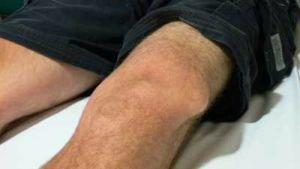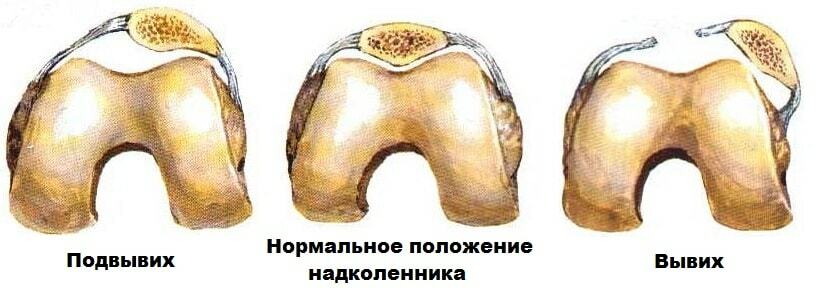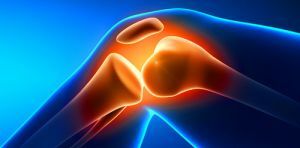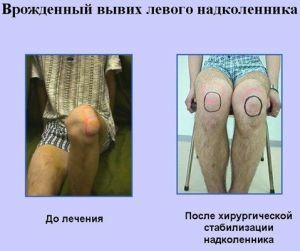 The patella is a small, but, in spite of this, a very important bone in the human body, which is localized in the knee joint( in its anterior part).
The patella is a small, but, in spite of this, a very important bone in the human body, which is localized in the knee joint( in its anterior part).
In fact, the patella is considered a sesamoid bone, such bones in medical terminology are commonly referred to as bones that are located in the tendon area. Sesamoid bones are not as many as it might seem at first glance, the patella is considered to be the largest of them.
The direct functions of the patella play a great role in the life of a person. This bone is primarily needed for each of us in order to increase muscle traction and increase its effectiveness, because the sesamoid bone works on the principle of block.
Also, the patella performs a protective function - it prevents the knee itself from damage and injuries. In most cases, performing the function of knee protection, the patella itself suffers. According to statistics, dislocations and fractures of the patella in medical practice occur, almost more often than other injuries.
- . What is a patella dislocation?preventive measures
What is a dislocation of the patella
Under the patellar dislocation, one should understand the displacement of the bone forward and its dovetailsIntensive contact with the external condyle of the femur.
In most cases, professional trainees turn to traumatologists with similar injuries, as their activity is associated with increased physical exertion, which can not but affect the state of health.
The degree of trauma of the patella is diagnosed and defined as complete or incomplete congenital dislocation of this bone.
At the same time, depending on the degree of lateral bias dislocation can be divided into the following subgroups:
- Easy degree of displacement .With her, a person does not feel any pain and discomfort. Trauma is diagnosed in case of accidental medical examination.
- Average degree of displacement .The main manifestation in this case can be considered a change in the gait of a person, it becomes unstable and is accompanied by frequent falls. On how much the sagittal plane will be severely injured, the manifestation of pain sensation depends.
- Severe degree of dislocation .Characterized by the inability to perform movements of the knee and strong pain in the area of the injured bone. At the same time there is a sharp increase in the tension of the muscles of the thigh, which only aggravates the patient's health for the worse.

There is also a classification according to the clinical course of the injury:
- dislocation permanently existing ;
- dislocation, which manifests itself suddenly after incorrect placement of the patella;
- dislocation habitual , in this case the bone is displaced each time after the joint makes any movement.
Pathological dislocation is also divided into several groups. These include the following:
- dislocation paralytic ( is the result of complete or partial paralysis of one of the muscles);
- dislocation habitual ( occurs due to weakening of the capsule, muscles and all groups of ligaments).
Habitual dislocation of
A habitual dislocation of the patella is an injury that is repeated with every perfect motion of an earlier injured knee joint. Most often this type of injury is experienced by athletes who are engaged in artistic gymnastics and game sports.
The valgus position of the knee joint, as well as the weakness of the inner head of the quadriceps muscle of the hip bone, the weakness of the joint capsule itself, which can develop as a result of previous injuries, can provoke the trauma.
Such an injury is most likely to be obtained in a position where the foot on which the support is made takes a semi-bent position, and the trunk performs rotations inside its axis, as well as at the moment of falling.
What could be causing the
to be injured The following reasons may lead to dislocation of the patella:
- sharp body twists;

- arthrosis;
- strong shocks on the kneecap;
- falls from height;
- performed operations on the knee or ligaments;
- physiologically high patella placement;
- congenital pathological changes in the structure of the bone, which lead to permanent injuries.
Developing symptomatology
Physicians have long distinguished a special group of symptoms, according to which it can be easily determined that a man has got a patella dislocation. In such a case it is very important to provide timely first aid to the victim and in the shortest possible time to deliver it to a medical institution.
Trauma is manifested by the following symptoms:
- the appearance of sharp and intense pain in the injured limb;
- the patella can deform( increase in size due to edema formation);
- with a careful examination, you yourself can see in which direction the patella has shifted;
- the victim has lost the ability to perform flexion and extension movements in the knee;
- over time, the pain becomes more pronounced;
- lacks the ability to lean on a sore leg;
- , the injured limb is highly swollen;
- may cause redness on the skin.
Diagnostic criteria and procedures
For the diagnosis of trauma in most cases, the traumatologist resorts to non-invasive methods. The main, of which are:
- X-ray study of ( for more accurate information, images are taken in several projections).

- Magnetic resonance imaging ( makes it possible to exclude the breaking of the meniscus, fracture of the patella, ruptures of knee ligaments and hemorrhages).However, it does not have a negative effect on the human body and is absolutely safe for health.
- Computed tomography also provides enough information to establish the correct diagnosis.
- If the diagnostic options described above do not give the desired result, the method of arthroscopy is used.
Based on the results of the research, the specialist describes the further course of treatment and recovery for the patient.
Treatment and recovery of
In most cases, surgical intervention is not used to treat dislocation, most experts refer to conservative patella repair methods:
- use of cold compresses to reduce pain;
- introduction of intramuscular pain medication;
- then there is a direct correction of the damaged bone;
- on the injured knee, compulsorily impose a plaster bandage for a duration of 3 to 6 weeks;
- the obligatory condition is the carrying out of physiotherapeutic procedures;
- , after removal of gypsum, repeated x-rays are performed;
- rehabilitation activities are conducted, both in a hospital and in a home environment.
Only patients with chronic and habitual dislocation of the patella are needed in the surgical intervention. In each case,  selects the most effective and safe method. Especially popular are:
selects the most effective and safe method. Especially popular are:
- plastic medial ligament( open);
- Transplantation of distal attachment;
- arthroscopic normalization of patella.
After the operation, a specialized immobilizing bandage is applied to the injured knee. The recovery period in this case can last from 2 to 3 months with the condition of compliance with all the recommendations of the doctor.
Complications and preventive measures
With correctly conducted treatment or surgical intervention of negative consequences after a patella dislocation it is possible to avoid. However, there is a possibility of developing involuntary primary dislocation and slow destruction of ligaments and cartilaginous tissue of the knee.
In order to prevent negative consequences and to avoid accidental knee injury, it is necessary to be as cautious and attentive as possible. Do not over-engage in heavy physical sports, daily perform heavy physical work.
If you suspect a patellar dislocation, you should urgently seek medical help.



